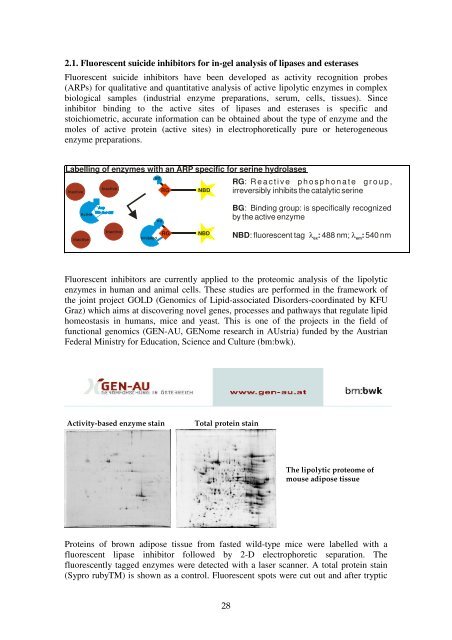Staff Members of the Institute of Biochemistry, TU Graz http://www ...
Staff Members of the Institute of Biochemistry, TU Graz http://www ...
Staff Members of the Institute of Biochemistry, TU Graz http://www ...
You also want an ePaper? Increase the reach of your titles
YUMPU automatically turns print PDFs into web optimized ePapers that Google loves.
2.1. Fluorescent suicide inhibitors for in-gel analysis <strong>of</strong> lipases and esterases<br />
Fluorescent suicide inhibitors have been developed as activity recognition probes<br />
(ARPs) for qualitative and quantitative analysis <strong>of</strong> active lipolytic enzymes in complex<br />
biological samples (industrial enzyme preparations, serum, cells, tissues). Since<br />
inhibitor binding to <strong>the</strong> active sites <strong>of</strong> lipases and esterases is specific and<br />
stoichiometric, accurate information can be obtained about <strong>the</strong> type <strong>of</strong> enzyme and <strong>the</strong><br />
moles <strong>of</strong> active protein (active sites) in electrophoretically pure or heterogeneous<br />
enzyme preparations.<br />
Labelling <strong>of</strong> enzymes with an ARP specific for serine hydrolases<br />
BG<br />
Inactive<br />
Inactive<br />
RG NBD<br />
RG: Reacti v e p h osphonate gr o up,<br />
irreversibly inhibits <strong>the</strong> catalytic serine<br />
Active<br />
BG<br />
BG: Binding group: is specifically recognized<br />
by <strong>the</strong> active enzyme<br />
Inactive<br />
Inactive<br />
Inhibited<br />
RG<br />
NBD<br />
NBD : fluorescent tag<br />
λ : 488 nm; λ : 540 nm<br />
ex<br />
em<br />
Fluorescent inhibitors are currently applied to <strong>the</strong> proteomic analysis <strong>of</strong> <strong>the</strong> lipolytic<br />
enzymes in human and animal cells. These studies are performed in <strong>the</strong> framework <strong>of</strong><br />
<strong>the</strong> joint project GOLD (Genomics <strong>of</strong> Lipid-associated Disorders-coordinated by KFU<br />
<strong>Graz</strong>) which aims at discovering novel genes, processes and pathways that regulate lipid<br />
homeostasis in humans, mice and yeast. This is one <strong>of</strong> <strong>the</strong> projects in <strong>the</strong> field <strong>of</strong><br />
functional genomics (GEN-AU, GENome research in AUstria) funded by <strong>the</strong> Austrian<br />
Federal Ministry for Education, Science and Culture (bm:bwk).<br />
Activity-based enzyme stain<br />
Total protein stain<br />
The lipolytic proteome <strong>of</strong><br />
mouse adipose tissue<br />
Proteins <strong>of</strong> brown adipose tissue from fasted wild-type mice were labelled with a<br />
fluorescent lipase inhibitor followed by 2-D electrophoretic separation. The<br />
fluorescently tagged enzymes were detected with a laser scanner. A total protein stain<br />
(Sypro rubyTM) is shown as a control. Fluorescent spots were cut out and after tryptic<br />
28














